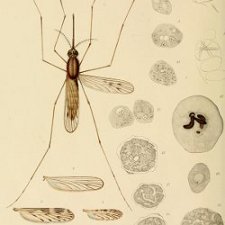Exploring the History of Malaria Transmission Modeling

Mosquitoes are responsible for the transmission of a multitude of pathogens including malaria, dengue and West Nile virus. Modeling the transmission patterns of mosquito-borne pathogens can inform public policy in the efforts to eradicate these diseases. I had a quick Q&A with David Smith, Professor of Epidemiology at the Johns Hopkins Malaria Research Institute, about his recent review, published in PLoS Pathogens, that pulls together the first 70 years of mathematical modeling of malaria transmission by exploring the work of Ronald Ross and George Macdonald.
What was your motivation to start studying malaria epidemiology?
It was a slippery slope. My academic interest was first sparked as a graduate student in mathematics. Malaria is a large, important problem with an interesting history. The epidemiology is very complex. It presents a durable intellectual challenge. I wanted to study it, but I resisted the urge because the complexity seemed overwhelming. I got pulled into it over the years by lots of people, but the most important ones were probably Ellis McKenzie, Simon Levin, and Ramanan Laxminarayan.

When did you become aware of the Ross-Macdonald model of mosquito-borne pathogen transmission?
It was one of the first things I learned about malaria. I’m not sure I can recall the first time I heard of it — probably in a class in population biology at Brigham Young University, or possibly when I first arrived at Princeton and started learning about mathematical epidemiology.
What prompted you and your co-authors to write a historical review of this model?
Earlier this year, PLoS Medicine published the malERA series, including a paper describing a research agenda for mathematical modeling for malaria eradication. As we wrote the historical review for the MalERA publication it became clear that there were limitations to previous commentaries and reviews describing the development of the Ross-Macdonald model.
We wanted to do a comprehensive review of mathematical models of mosquito-transmitted pathogens, so we compiled a comprehensive bibliography. The “Ross-Macdonald model” and its progeny now include approximately 600 peer-reviewed manuscripts and we had a hard time organizing the analysis. We recognized informally that many papers had influenced the Ross-Macdonald model, so we decided to devise a metric that we could use to measure similarity. That decision precipitated a need to define the Ross-Macdonald model in very rigorous terms, and it was then that we realized the “Ross-Macdonald” model was not any one thing. It is a “scientific theory” in the classical sense: a deliberately simplified set of concepts, abstractions, and quantities that conform to available data to explain a certain class of phenomena.
Do you think there is room to further build upon these theories?
I think so, but not by doing more of the same. Mathematical epidemiologists need to spend more time trying to break their models and see how they stand up to serious scrutiny. One of the things I think current models do very poorly is to consider the properties of transmission — how is the pathogen dispersed in space and time by mosquitoes and their human (or other vertebrate animal) hosts? We have some clues that this is one of the things that the models get wrong, but this is one of the most neglected areas for mosquito-transmitted pathogen models.
What do you see as next direction for this area of epidemiology?
I’d like to see the models integrated and applied in vector-borne disease control programs — and I mean really used to design and evaluate intervention protocols — but there are a lot of intellectual problems yet to be solved. How do you integrate all the information streams about mosquito-borne pathogen transmission and use that information to improve the efficiency of a control program? It’s a formidable intellectual problem, but it’s an even bigger human problem. The people and institutions that work to control malaria and dengue are as complex as the epidemiological and ecological problems it poses. But the main message is that it is an urgent problem, especially in light of the evolution of antimalarial drug resistance, insecticide resistance, and the volatile funding environment.
What impresses me most, despite all of the complexity and failures, is that malaria has been in retreat for a century. I think we can continue to make it retreat — I think that’s the task for scientists in my lifetime — how can we eliminate malaria from half the countries where it now exists? As long as it keeps shrinking, the end of malaria is inevitable.
Read the review: Ross, Macdonald, and a Theory for the Dynamics and Control of Mosquito-Transmitted Pathogens.
More information on malERA – a research agenda for malaria eradication.
